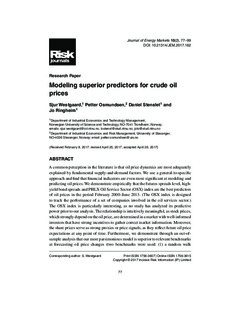Modeling superior predictors for crude oil prices
Journal article, Peer reviewed
Published version
Permanent lenke
http://hdl.handle.net/11250/2494781Utgivelsesdato
2017Metadata
Vis full innførselSamlinger
Sammendrag
A common perception in the literature is that oil price dynamics are most adequately explained by fundamental supply-and-demand factors. We use a general-to-specific approach and find that financial indicators are even more significant at modeling and predicting oil prices. We demonstrate empirically that the futures spreads level, high-yield bond spreads and PHLX Oil Service Sector (OSX) index are the best predictors of oil prices in the period February 2000–June 2013. (The OSX index is designed to track the performance of a set of companies involved in the oil services sector.) The OSX index is particularly interesting, as no study has analyzed its predictive power prior to our analysis. The relationship is intuitively meaningful, as stock prices, which strongly depend on the oil price, are determined in a market with well-informed investors that have strong incentives to gather correct market information. Moreover, the share prices serve as strong proxies or price signals, as they reflect future oil price expectations at any point of time. Furthermore, we demonstrate through an out-of-sample analysis that our most parsimonious model is superior to relevant benchmarks at forecasting oil price changes (two benchmarks were used: (1) a random walk and (2) ARIMA.2; 0; 2/, which was optimized in-sample by minimizing the Akaike information criterion). Our findings do not necessarily imply that the financial sector determines oil prices. On the contrary, we take the view that fundamental information is traceable from financial markets, and, hence, financial predictors serve as indicators for oil price fundamentals.
